Versuchsanstalt fuer Oelmotore Engines
Engine Models, designed by Versuchsanstalt Aachen:
M 11 - Gas Engine, November 1904, built at Versuchsanstalt Aachen
M 12 - Oil Engine, February 1908, built by Soest + Co, Dusseldorf
M 13 - Small Oil Engine, projected 1909, not built
M 14 - Small Oil Engine, projected 1909, not built
M 15 - Oil Engine, May 1910, built by Gebr. Klein, Dahlbruch
M 16 - nothing known
M 17 - Oil Engine, projected 1911, not built
M 18 - Oil Engine, 1913, built by Jumo Magdeburg
M 19 - Oil Engine, projected 1913, not built
M 20 - nothing known
M 21 - nothing known
M 22 - Ship Oil Engine, 1913, built by Gebr. Klein, Dahlbruch
M 23 - Oil Engine, 1914, built by Jumo Magdeburg
M 24 - Oil Engine, 1913, 6 engines built by Gebr. Klein, Dahlbruch and Jumo Magdeburg
M 25 - Oil Engine, 1913, built by Jumo Magdeburg
M 26 - nothing known
M 27 - Oil Engine, 1914, probably built by Jumo Magdeburg, not delivered
C180 - Ship Engine, 1920, started at Magdeburg, finished at Aachen
Engines, built under license of the Versuchsanstalt Aachen:
Wotan (unknown, 1911)
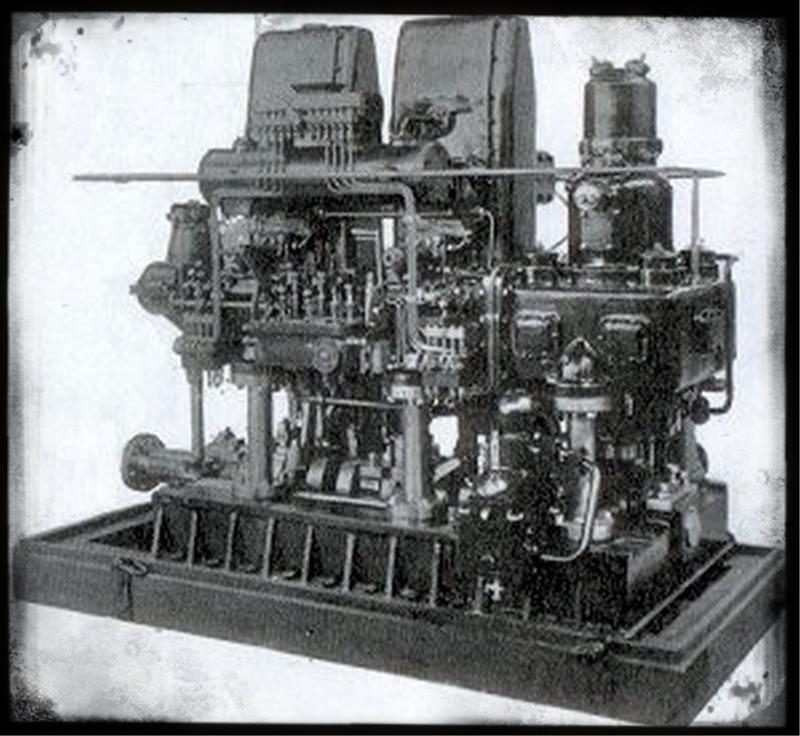
In 1911 the J. Frerichs + Co. A.G. at Osterholz-Scharmbeck built a ship oil engine with 74kW/100hprs, which used the Junkers tandem design of the M12. This engine was integrated into the fishing vessel Wotan in 1912. The ship reached a speed of 7 ktns. per hour. It was successfully presented at the Copenhagen Shipping Exhibition in 1912.
Technical Data:
2 Cylinder, bore: 200mm, stroke: 2 x 240mm, turnrate: 260 rpm, 74kW/100hprs.
Hongkong Ferry (Garrels + Boerner, 1911)
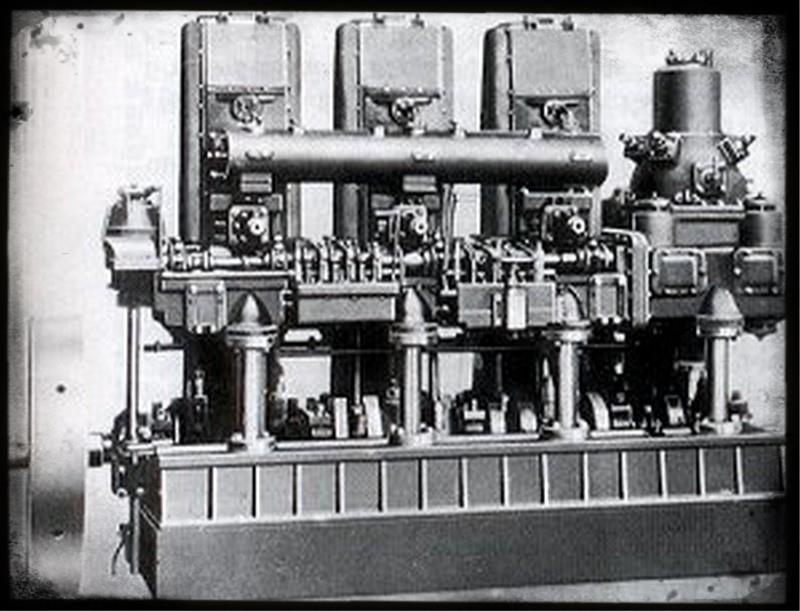
Another engine was built by J. Frerichs + Co. A.G. in 1911 for the Hongkong based merchandise company Garrels + Boerner. It was a three cylinder 96kW/130hprs engine, which was fitted into a ferry boat at Hongkong in 1912.
Technical Data:
3 Cylinder, bore: 200mm, stroke: 480mm, turnrate: 310 rpm, 96kW/130hprs.
Arthur von Gwinner (Deutsche Petroleum A.G., 1912)
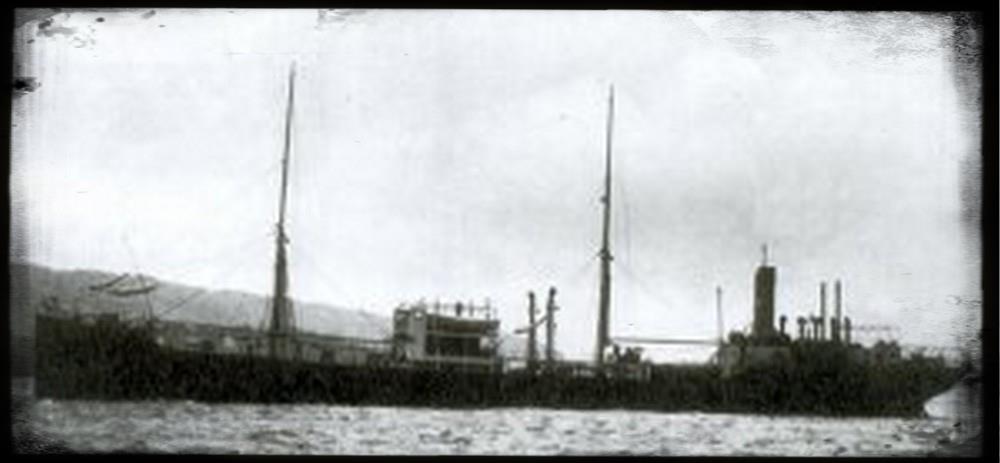
In 1912 the Deutsche Petroleum A.G. asked for two 478kW/650hprs. ship engines for their new 4200to. tank ship Arthur von Gwinner. The engines again were built by J. Frerichs + Co. A.G.. But these Junkers based engines were not reliable and in 1917 they were removed and changed with steam engines.
Technical Data:
2 Cylinder, bore: 440mm, stroke: 2 x 520mm, turnrate: 180 rpm, 478kW/650hprs.
Primus (A.G.-Weser / Frerichs, 1912)
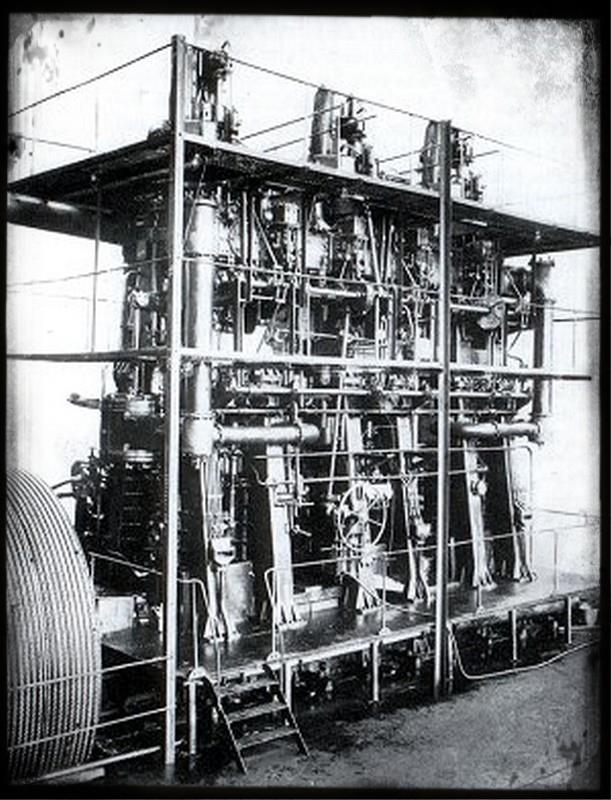
While Frerichs built the above engines on request of the Versuchsanstalt for Junkers, in 1912 J. Frerichs + Co. A.G. and the shipyard of A.G. Weser at Bremerhaven made a license agreement with Junkers for own ship engine constructions based on the Junkers Tandem engines. Based on a single 195kW/266hprs. Tandem engine, A.G.-Weser constructed a block of three engines, which were used on a single ship wave. Two of these blocks were built by Frerichs in 1913 and these engines were used for the new 6500to. freighter Primus of the Hamburg Amerika Line. However, these two engines did not show enough reliability and later they were removed.
Technical Data:
6 Cylinder, bore: 400mm, stroke: 2 x 400mm, turnrate: 120 rpm, 2 x 588kW/800hprs.
--- (Badenia, August 1912)
In August 1912 the Maschinenfabrik Badenia signed a license agreement with Junkers for the construction of a 147kW/200hprs stationary two cylinder tandem engine. The engine is built at Badenia with the support of Versuchsanstalt people.
Technical Data:
2 Cylinder, bore: ????mm, stroke: 2 x ????mm, turnrate: ???? rpm, 147-220kW/200-300hprs.
Submarine Engine (Maschinenfabrik Gebr. Nobel, December 1911)
Alfred and Emanuel Nobel were interested in oil engines since the beginning 20th century. In 1907 they produce an own oil engine at their St. Petersburg engine factory. In 1912 Emanuel Nobel and M.S. Plotnikov founded a new shipbuilding company Noblessner at Revel. This company arranged an agreement with the Russian Navy for the construction of its future submarine fleet. Noblessner signed a contract with the Maschinenfabrik Gebr. Nobel for the engine supply of these submarines.
Already in 1911 Emanuel Nobel asked Junkers for the design of a two cylinder experimental engine, which later could be used as a prototype for the serial production of submarine engines at the Nobel factory in Petersburg. An initial contract for the prototype construction was signed in December 1911 and in March 1913 Nobel received a license contract for serial production of the submarine engine.
The breakout of WW I delayed the Noblessner developement of submarines but in 1916 eight submarines were delivered to the Russian Navy, i.e. "Bars", "Tigr", "Lvitsa", "Rys", "Pantera", "Volk". These boats got a 500hprs diesel engine like the Junkers developement had. However, it is uncertain if these engines are directly derivates of the Junkers engine. Further details on these submarines might be here.
Technical Data:
2 Cylinder, bore: 300 mm, stroke: 600 mm, turnrate: 370 rpm, 368kW/500hprs.
--- (General Electric, 1911)
Since 1909 General Electric was investigating gasoline-electric engine designs for locomotives. In 1911 a team of engineers was sent to Europe, where they also learnt about the Junkers Diesel engines. General Electric signed a license agreement with Junkers for the opposed piston engine and five experimental diesel-electric switch engines were built until 1915. However, these test engines did not show the required performance and General Electric dropped this design for their railroad approach.
--- (Maschinenbau Sormovo A.G., March 1912)
At Nizhny Novgorod one of Russia's leading shipyards was located under the name of Sormovo Engine Factory. Since 1849 this factory produced riverboats for Volga shipping companies, as well as railway cars. In 1912 Sormovo asked Junkers for the design of a diesel oil engine for one of their new riverboats. In March 1912 a license agreement for the prototype construction of this engine was signed and in 1913 a prototype was built at Nizhny Novgorod. The prototype was mounted on wheel steamer and went well for a few years.
Technical Data:
6 Cylinder, bore: 390 mm, stroke: 2 x 390 mm, turnrate: 180 rpm, 368kW/500hprs.
--- (Doxford and Sons, January 1913)
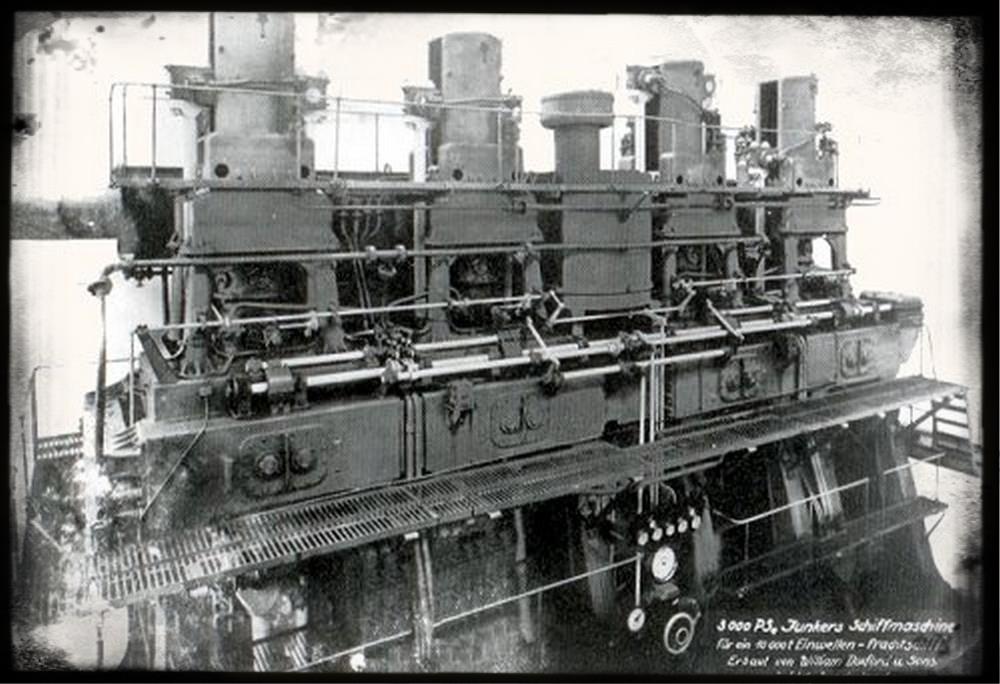
Shortly before WW I the Sunderland based shipyard of Doxford and Sons started studies for an efficient oil engine for motor driven tramp steamers. In 1912 Doxfords obtained the sole U.K. licence to build the opposed piston design of Oechelhauser and Junkers. Experimenting began on a single piston diesel unit, which was abandoned after just one month. Junkers' staff was sent to Sunderland to support Doxford's chief engineer Keller and Purdie during the construction of the engine. A lot of design inefficencies were solved prior to the breakout of WW I. In 1913 an opposed piston engine with a bore of 500mm with equal strokes for upper and lower pistons of 750mm, which produced 450BHP at 130rpm. M.I.P. was 100lbs /m2 was started. At the breakout of WW I the cooperation between Junkers and Doxford came to an end. Doxford continued the developements during WW I.
But after WW I the cooperation was reinitiated again. Doxford aquired the license rights for serial production of an improved Junkers engine design. In 1921 two Junkers-Doxford oil engines are integrated into the M.S. Ingarem and M.S. Devon-City. These engines were large scale engines of 3000 PS. Further fourteen engines were built and used in Doxford ships until 1926.
Doxford and Sons Ltd. also sold license contracts for the Junkers-Doxford engine to Sin Ship Building Company in the U.S.A. The cooperation between Doxford and Junkers therefore became the most successfull engagement of Junkers' oil engines, which was finally terminated in the mid-20s.
Ships, equipped with Doxford-Junkers Engines:
Yngaren (1921, 9000to., 3000PS, to Sweden)
Devon-City (1921, ????to., 3000PS)
Pacific Commerce (9000to., 2700PS)
Eknaren (9000to., 3000PS, to Sweden)
Pacific Shipper (9500to., 3200PS)
Pacific Trader (9500to., 2900PS)
Silverelm (1924, 8000to., 1760PS 2-stroke 85in., single acting oil engine, 3 cylinders of 21 3/4in. diameter, to Silver Line U.K.)
Silverfir (1924, 8225to., 1760PS, to U.K.)
Silvercedar (8000to., 1760PS)
Vinemoor (8000to., 1760PS)
Westmoor (8000to., 1760PS)
Port Dunedin (1925, 10000to., 4840PS double engine)
Silvafield (8000to., 2500PS)
Silveray (8000to., 2200PS)
Port Hobart (July 19257448to., 4940PS double engine)
Tynefield (8000to., 2850PS)
Technical Data:
1 Cylinder, bore: 500 mm, stroke: 1500 mm, turnrate: 150 rpm, 2 x 551kW/750hprs.
Read more at
Doxford Engine (differences between Junkers and Doxford)
Doxford Engine Developements (Doxford engine data)
Doxford History (focused on the company history)
--- (Fairbanks Morse, ????)
During the thirties the U.S. Navy ordered a larger number of submarines. These boats were powered by different types of engines. One type was developed by Fairbanks Morse as an 8 cylinder opposed piston diesel engine, which was based on the Junkers patent.
Technical Data:
38A8: 8 Cylinder, bore: 8'', stroke: 2 x 10'', turnrate: ??? rpm, 1300 hprs.
38D8-1/8: 8 Cylinder, bore: ??? mm, stroke: 2 x ??? mm, turnrate: ??? rpm, 1365hprs.
38D8-1/8: 9 Cylinder, bore: 8'', stroke: 2 x 10'', turnrate: 720 rpm, 1535hprs.
used on SS179/180 after reengined, SS201 and later
38D8-1/8: 10 Cylinder, bore: ??? mm, stroke: 2 x ??? mm, turnrate: ??? rpm, 1600hprs.
used on submarines SS381 and later
38A6-3/4: 8 Cylinder, bore: 6,75'', stroke: 2 x 8,5'', turnrate: 1335 rpm, 1000 hprs.
post war light version
Futher Links:
Fairbanks Morse (the company's Homepage)
Submarine Main Propulsion Diesels (with infos about U.S. submarine engines)
Further License Partners for Junkers Oil Engines:
Maschinenbau A.G. Gebrueder Klein
(Dahlbruch, May 1911)
Allgemeine Elektrizitaets Gesellschaft - AEG
Berlin, July 1911)
Erhardt und Sehmer
(Saarbruecken, May 1912)
Maschinenfabrik Dujardin und Co.
(Lille, April 1913)
Maschinenfabrik Augsburg Nuernberg A.G. (MAN)
(Nuernberg, February 1914)
Peugot
(France, 1914)
introduced Aug 1996, transfered Dec 2017
http://hugojunkers.bplaced.net/
contents last updated 9 Jul 2004

